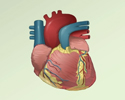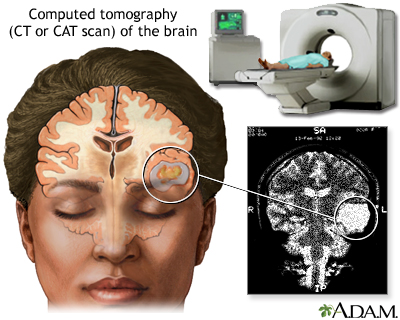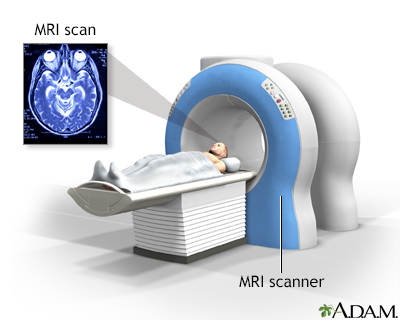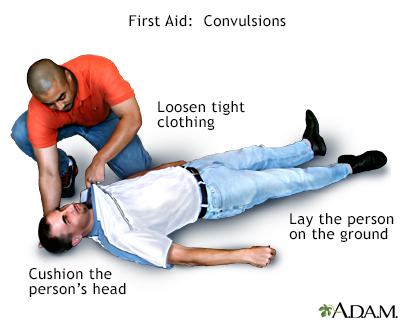Seizures
A seizure is the physical changes in behavior that occurs during an episode of specific types of abnormal electrical activity in the brain.
The term "seizure" is often used interchangeably with "convulsion." During convulsions a person has uncontrollable shaking that is rapid and rhythmic, with the muscles contracting and relaxing repeatedly. There are many different types of seizures. Some have mild symptoms without shaking.
Seizures - Animation
Having a brain seizure can be a terrifying experience. If you have a seizure, there was a problem with too much uncoordinated electrical activity in your brain. In general, a seizure is when too many of your brain cells become excited at the same time. There are two different types of seizures, generalized and partial. With a generalized seizure, your brain has abnormal electrical activity on both sides of your brain. Partial seizures happen when electrical activity surges in one part of your brain. Seizures can happen for many reasons; It may be from high levels of salt or sugar in your blood; brain injury from a stroke or head injury brain problems you are born with or perhaps a brain tumor. Dementia, such as Alzheimer's disease, high fever or illnesses or infections that hurt your brain. Illegal drug use or withdrawal from alcohol or drug use can cause seizures as well. So, what are the signs that someone is having a seizure? Some people with seizures may have simple staring spells, while others have violent, uncontrollable shaking and loss of consciousness. Some people will see flashing lights, others may hallucinate. Some people may have strange sensations, such as tingling, smelling an odor that isn't really there, or emotional changes. Most people who have a seizure for the first time will go to the emergency room. The doctor will do tests to rule out medical causes, such as a stroke. You may have blood tests, CT or MRI scans of your head, or a spinal tap. Treatment depends on the cause of your seizure. For example, if a seizure was caused by fever, treatment will focus on bringing the fever down. Your doctor may send you home with some medicines to help you avoid having more seizures if there is reason to think you are at continued risk of seizures. You should get plenty of sleep and try to keep as regular a schedule as possible, and try to avoid too much stress. Most people with seizures can have a very active lifestyle. Plan ahead for the possible dangers of a certain activity. Avoid any activity where loss of consciousness would be dangerous until it is clear that seizures are unlikely to occur again.
Considerations
It may be hard to tell if someone is having a seizure. Some seizures only cause a person to have staring spells. These may go unnoticed.
Staring spells
An absence seizure is the term for a type of seizure involving staring spells. This type of seizure is a brief (usually less than 15 seconds) change...

Specific symptoms depend on which part of the brain is involved. Symptoms occur suddenly and may include:
- Brief blackout followed by a period of confusion (the person cannot remember for a short time)
Confusion
Confusion is the inability to think as clearly or quickly as you normally do. You may feel disoriented and have difficulty paying attention, remembe...
 ImageRead Article Now Book Mark Article
ImageRead Article Now Book Mark Article - Changes in behavior, such as picking at one's clothing
- Drooling or frothing at the mouth
- Eye movements
- Grunting and snorting
- Loss of bladder or bowel control
- Mood changes, such as sudden anger, unexplainable fear, panic, joy, or laughter
- Shaking of the entire body
- Sudden falling
- Tasting a bitter or metallic flavor
- Teeth clenching
- Temporary stop in breathing
- Uncontrollable muscle spasms with twitching and jerking limbs
Symptoms may stop after a few seconds or minutes, or continue for up to 15 minutes. They rarely continue longer.
The person may have warning symptoms before the attack, such as:
- Fear or anxiety
- Nausea
Nausea
Nausea is feeling an urge to vomit. It is often called "being sick to your stomach. "Vomiting or throwing-up forces the contents of the stomach up t...
 ImageRead Article Now Book Mark Article
ImageRead Article Now Book Mark Article - Vertigo (feeling as if you are spinning or moving)
- Visual symptoms (such as flashing bright lights, spots, or wavy lines before the eyes)
Causes
Seizures of all types are caused by abnormal electrical activity in the brain.
Causes of seizures can include:
- Abnormal levels of sodium or glucose in the blood
- Brain infection, including meningitis and encephalitis
Meningitis
Meningitis is an infection of the membranes covering the brain and spinal cord. This covering is called the meninges.
 ImageRead Article Now Book Mark Article
ImageRead Article Now Book Mark ArticleEncephalitis
Encephalitis is irritation and swelling (inflammation) of the brain, most often due to infections.
 ImageRead Article Now Book Mark Article
ImageRead Article Now Book Mark Article - Brain injury that occurs to a baby during labor or childbirth
- Brain problems that occur before birth (congenital brain defects)
- Brain tumor (a rare cause)
Brain tumor
A brain tumor is a group (mass) of abnormal cells that grow in the brain. This article focuses on primary brain tumors in children.
 ImageRead Article Now Book Mark Article
ImageRead Article Now Book Mark Article - Electric shock
Electric shock
An electrical injury is damage to the skin or internal organs when a person comes into direct contact with an electrical current.
 ImageRead Article Now Book Mark Article
ImageRead Article Now Book Mark Article - Epilepsy
Epilepsy
Epilepsy is a brain disorder in which a person has repeated seizures over time. Seizures are episodes of uncontrolled and abnormal electrical activi...
 ImageRead Article Now Book Mark Article
ImageRead Article Now Book Mark Article - Fever (particularly in young children)
Fever
Fever is the temporary increase in the body's temperature in response to a disease or illness. A child has a fever when the temperature is at or abov...
 ImageRead Article Now Book Mark Article
ImageRead Article Now Book Mark ArticleYoung children
A febrile seizure is a convulsion in a child triggered by a fever.
 ImageRead Article Now Book Mark Article
ImageRead Article Now Book Mark Article - Head injury
Head injury
A head injury is any trauma to the scalp, skull, or brain. Head injury can be either closed or open (penetrating). A closed head injury means you rec...
 ImageRead Article Now Book Mark Article
ImageRead Article Now Book Mark Article - Heart disease
Heart disease
Coronary heart disease is a narrowing of the blood vessels that supply blood and oxygen to the heart. Coronary heart disease (CHD) is also called co...
 ImageRead Article Now Book Mark Article
ImageRead Article Now Book Mark Article - Heat illness (heat intolerance)
Heat intolerance
Heat intolerance is a feeling of being overheated when the temperature around you rises. It can often cause heavy sweating. Heat intolerance usually...
 ImageRead Article Now Book Mark Article
ImageRead Article Now Book Mark Article - High fever
Fever
Fever is the temporary increase in the body's temperature in response to a disease or illness. A child has a fever when the temperature is at or abov...
 ImageRead Article Now Book Mark Article
ImageRead Article Now Book Mark Article - Phenylketonuria (PKU), which can cause seizures in infants
PKU
Phenylketonuria (PKU) is a rare condition in which a baby is born without the ability to properly break down an amino acid called phenylalanine....
 ImageRead Article Now Book Mark Article
ImageRead Article Now Book Mark Article - Poisoning
- Street drugs, such as angel dust (PCP), cocaine, and amphetamines
- Stroke
Stroke
A stroke occurs when blood flow to a part of the brain stops. A stroke is sometimes called a "brain attack. " If blood flow is cut off for longer th...
 ImageRead Article Now Book Mark Article
ImageRead Article Now Book Mark Article - Toxemia of pregnancy
Toxemia of pregnancy
Preeclampsia is high blood pressure and signs of liver or kidney damage that occur in women after the 20th week of pregnancy. While it is rare, pree...
 ImageRead Article Now Book Mark Article
ImageRead Article Now Book Mark Article - Toxin buildup in the body due to liver or kidney failure
Kidney failure
Acute kidney failure is the rapid (less than 2 days) loss of your kidneys' ability to remove waste and help balance fluids and electrolytes in your b...
 ImageRead Article Now Book Mark Article
ImageRead Article Now Book Mark Article - Very high blood pressure (malignant hypertension)
Malignant hypertension
Malignant hypertension is very high blood pressure that comes on suddenly and quickly.
 ImageRead Article Now Book Mark Article
ImageRead Article Now Book Mark Article - Venomous bites and stings (such as a snake bite)
Snake bite
Snake bites occur when a snake bites the skin. They are medical emergencies if the snake is venomous. Venomous animals account for a large number of...
 ImageRead Article Now Book Mark Article
ImageRead Article Now Book Mark Article - Withdrawal from alcohol or certain medicines after using it for a long time
Alcohol
Alcohol withdrawal refers to symptoms that may occur when a person who has been drinking too much alcohol on a regular basis suddenly stops drinking ...
Read Article Now Book Mark Article
Sometimes, no cause can be found. This is called idiopathic seizures. They are usually seen in children and young adults, but can occur at any age. There may be a family history of epilepsy or seizures.
Epilepsy
Epilepsy is a brain disorder in which a person has repeated seizures over time. Seizures are episodes of uncontrolled and abnormal electrical activi...

Idiopathic epilepsy and seizure - Animation
Idiopathic epilepsies are typically associated with generalized seizures which begin simultaneously in both cerebral hemispheres. Some generalized idiopathic epilepsies are present at birth, whereas others have an aged dependent pattern of onset and remit spontaneously. Idiopathic epilepsies usually have a complex inheritance pattern and are poorly understood. Some have been associated with single gene mutations. For example, certain mutations in genes encoding voltage-gated ion channel proteins produce a state of neuronal hyperexcitability. Individuals with these mutations are thus more susceptible to seizures.
If seizures continue repeatedly after any underlying problem is treated, the condition is called epilepsy.
Home Care
Most seizures stop by themselves. But during a seizure, the person can be hurt.
When a seizure occurs, the main goal is to protect the person from injury:
- Try to prevent a fall. Lay the person on the ground in a safe area. Clear the area of furniture or other sharp objects.
- Cushion the person's head.
- Loosen tight clothing, especially around the neck.
- Turn the person on their side. If vomiting occurs, this helps make sure that the vomit is not inhaled into the lungs.
- Look for a medical ID bracelet with seizure instructions.
- Stay with the person until they recover or until professional medical help arrives.
Things friends and family members should NOT do:
- DO NOT restrain (try to hold down) the person.
- DO NOT place anything between the person's teeth during a seizure (including your fingers).
- DO NOT attempt to hold the person's tongue.
- DO NOT move the person unless they are in danger or near something hazardous.
- DO NOT try to make the person stop convulsing. They have no control over the seizure and are not aware of what is happening at the time.
- DO NOT give the person anything by mouth until the convulsions have stopped and the person is fully awake and alert.
- DO NOT start CPR unless the seizure has clearly stopped and the person is not breathing or has no pulse.
If a baby or child has a seizure during a high fever, cool the child slowly with lukewarm water. DO NOT place the child in a cold bath. Call your child's health care provider and ask what you should do next. Also, ask if it is OK to give the child acetaminophen (Tylenol) once they are awake.
When to Contact a Medical Professional
Call 911 or the local emergency number if:
- This is the first time the person has had a seizure
- A seizure lasts more than 2 to 5 minutes
- The person does not awaken or have normal behavior after a seizure
- Another seizure starts soon after a seizure ends
- The person had a seizure in water
- The person is pregnant, injured, or has diabetes
- The person does not have a medical ID bracelet (instructions explaining what to do)
- There is anything different about this seizure compared to the person's usual seizures
Report all seizures to the person's provider. The provider may need to adjust or change the person's medicines.
What to Expect at Your Office Visit
A person who has had a new or severe seizure is usually seen in a hospital emergency room. The provider will try to diagnose the type of seizure based on the symptoms.
Tests will be done to rule out other medical conditions that cause seizures or similar symptoms. This may include fainting, transient ischemic attack (TIA) or stroke, panic attacks, migraine headaches, sleep disturbances, and other possible causes.
Transient ischemic attack (TIA)
A transient ischemic attack (TIA) occurs when blood flow to a part of the brain stops for a brief time. A person will have stroke-like symptoms for ...

Panic attacks
Panic disorder is a type of anxiety disorder in which you have repeated attacks of intense fear that something bad will happen.
Read Article Now Book Mark ArticleMigraine headaches
A migraine is a type of headache. It may occur with symptoms such as nausea, vomiting, or sensitivity to light and sound. In most people, a throbbi...

Tests that may be ordered include:
- Blood and urine tests
- CT scan of the head or MRI of the head
CT scan
A computed tomography (CT) scan is an imaging method that uses x-rays to create pictures of cross-sections of the body. Related tests include:Abdomin...
 ImageRead Article Now Book Mark Article
ImageRead Article Now Book Mark ArticleMRI
A magnetic resonance imaging (MRI) scan is an imaging test that uses powerful magnets and radio waves to create pictures of the body. It does not us...
 ImageRead Article Now Book Mark Article
ImageRead Article Now Book Mark Article - EEG (usually not in the emergency room)
EEG
An electroencephalogram (EEG) is a test to measure the electrical activity of the brain.
 ImageRead Article Now Book Mark Article
ImageRead Article Now Book Mark Article - Lumbar puncture (spinal tap)
Further testing is needed if a person has:
- A new seizure without a clear cause
- Epilepsy (to make sure the person is taking the right amount of medicine)
Reviewed By
Joseph V. Campellone, MD, Department of Neurology, Cooper Medical School of Rowan University, Camden, NJ. Review provided by VeriMed Healthcare Network. Internal review and update on 02/23/24 by David C. Dugdale, MD, Medical Director, Brenda Conaway, Editorial Director, and the A.D.A.M. Editorial team.
Abou-Khalil BW, Gallagher MJ, Macdonald RL. Epilepsies. In: Jankovic J, Mazziotta JC, Pomeroy SL, Newman NJ, eds. Bradley's and Daroff's Neurology in Clinical Practice. 8th ed. Philadelphia, PA: Elsevier; 2022:chap 100.
Krumholz A, Wiebe S, Gronseth GS, et al. Evidence-based guideline: management of an unprovoked first seizure in adults: report of the Guideline Development Subcommittee of the American Academy of Neurology and the American Epilepsy Society. Neurology. 2015;84(16):1705-1713. PMID: 25901057 pubmed.ncbi.nlm.nih.gov/25901057/. Reaffirmed on February 10, 2024.
Maciel CB, Elie-Turrene M-C. Seizure. In: Walls RM, ed. Rosen's Emergency Medicine: Concepts and Clinical Practice. 10th ed. Philadelphia, PA: Elsevier; 2023:chap 92.
Mikati MA, Tchapyjnikov D. Seizures in childhood. In: Kliegman RM, St. Geme JW, Blum NJ, Shah SS, Tasker RC, Wilson KM, eds. Nelson Textbook of Pediatrics. 21st ed. Philadelphia, PA: Elsevier; 2020:chap 611.
Wiebe S. The epilepsies. In: Goldman L, Cooney KA, eds. Goldman-Cecil Medicine. 27th ed. Philadelphia, PA: Elsevier; 2020:chap 372.






 All rights reserved.
All rights reserved.